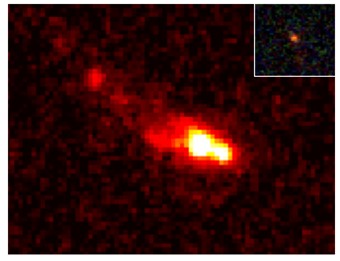Galaxies and stars developed faster after the Big Bang than expected
Detailed pictures of one of the very first galaxies show growth was much faster than we thought
An international research team have made unprecedentedly detailed observations of the earliest merger of galaxies ever witnessed. They suggest stars developed much faster and more efficiently than we thought.
They used the James Webb Space Telescope (JWST) to observe the massive object as it was 510 million years after the Big Bang – i.e. around 13 billion years ago.
When we conducted these observations, this galaxy was ten times more massive than any other galaxy found that early in the Universe, says Dr Kit Boyett, an ASTRO 3D Research Fellow on First Galaxies, from the University of Melbourne. He is lead author on a paper published in Nature Astronomy. The paper has 27 authors from 19 institutions in Australia, Thailand, Italy, the USA, Japan, Denmark and China.
JWST, launched in 2021, is enabling astronomers to see the early Universe in ways that were previously impossible. Objects that appeared as single points of light through earlier telescopes such as the Hubble Space Telescope, are revealing their complexity.
"It is amazing to see the power of JWST to provide a detailed view of galaxies at the edge of the observable Universe and therefore back in time" says Prof. Michele Trenti, ASTRO 3D First Galaxies theme leader and University of Melbourne node leader. "This space observatory is transforming our understanding of early galaxy formation" adds Prof. Trenti.
The observations in the current paper show a galaxy consisting of several groups with two components in the main group and a long tail, suggesting an ongoing merger of two galaxies into a larger one.
“The merger hasn't finished yet. We can tell this by the fact we still see two components. The long tail is likely produced by some of the matter being cast aside during the merger. When two things merge, they sort of throw away some of the matter. So, this tells us that there's a merger and this is the most distant merger ever seen,” says Dr Boyett.
This and other observations using the JWST is causing astrophysicists to adjust their modelling of the early years of the Universe.
“With James Webb we are seeing more objects in the early cosmos than we expect to see, and those objects are more massive than we thought as well,” says Dr Boyett. “Our cosmology isn't necessarily wrong, but our understanding of how quickly galaxies formed probably is, because they are more massive than we ever believed could be possible.”
Dr Boyett’s team’s findings show these galaxies were able to accumulate mass so fast by merging.
But it is not only the size of the galaxies and the speed with which they grew that surprises Dr Boyett. His paper for the first time describes the population of stars that make up the merging galaxies – another detail made possible by JWST.
“When we compared our spectrum analysis with our imaging, we found two different things. The image told us the population of stars was young, but the spectroscopy spoke of stars that are quite old. But it turns out both are correct because we don't have one population of stars but two,” Boyett says.
“The old population has been there for a long time and what we believe happens is the merger of the galaxies produces new stars and that's what we're seeing in the imaging – new stars on top of the old population.”
Most studies of these very distant objects show very young stars, but this is because the younger stars are brighter and so their light dominates the imaging data. The JWST, however, allows for such detailed observations the two populations can be distinguished.
“It's the fact that the spectroscopy is so detailed, we can see the subtle features of the old stars that tell us actually there's more there than you think,” says Dr Boyett.
“This is not all that surprising, we know that over the history of a universe there are peaks of new star formation for various reasons, and that results in multiple populations.
“But it's the first time we've really seen them at this distance.”
The paper has significant implications for current modelling.
“Our simulations can produce an object similar to the one we observed, roughly at the same age of a universe, and roughly the same mass, however, it's incredibly rare. So rare there's only one of these in the whole model. The chance of us observing that with our observations, then suggest we either incredibly lucky or our simulations are wrong, and this sort of object is more common than we think,” says Dr Boyett.
“The thing we think we're missing is that stars were forming much more efficiently and that may be what we need to change in our models.”
About us:
About ASTRO 3D
The ARC Centre of Excellence for All Sky Astrophysics in 3 Dimensions (ASTRO 3D) is a $40 million Research Centre of Excellence funded by the Australian Research Council (ARC) and nine collaborating Australian universities: The Australian National University, The University of Sydney, The University of Melbourne, Swinburne University of Technology, The University of Western Australia, Curtin University, Macquarie University, The University of New South Wales, and Monash University.
Contact details:
Bill Condie (For ASTRO 3D)
Ph: +61 450 952 365, bill@scienceinpublic.com.au
Vanessa Williams (University of Melbourne)
Ph: +61 422 261 937, Vanessa.williams1@unimelb.edu.au
The paper is available at: https://doi.org/10.1038/s41550-024-02218-7


